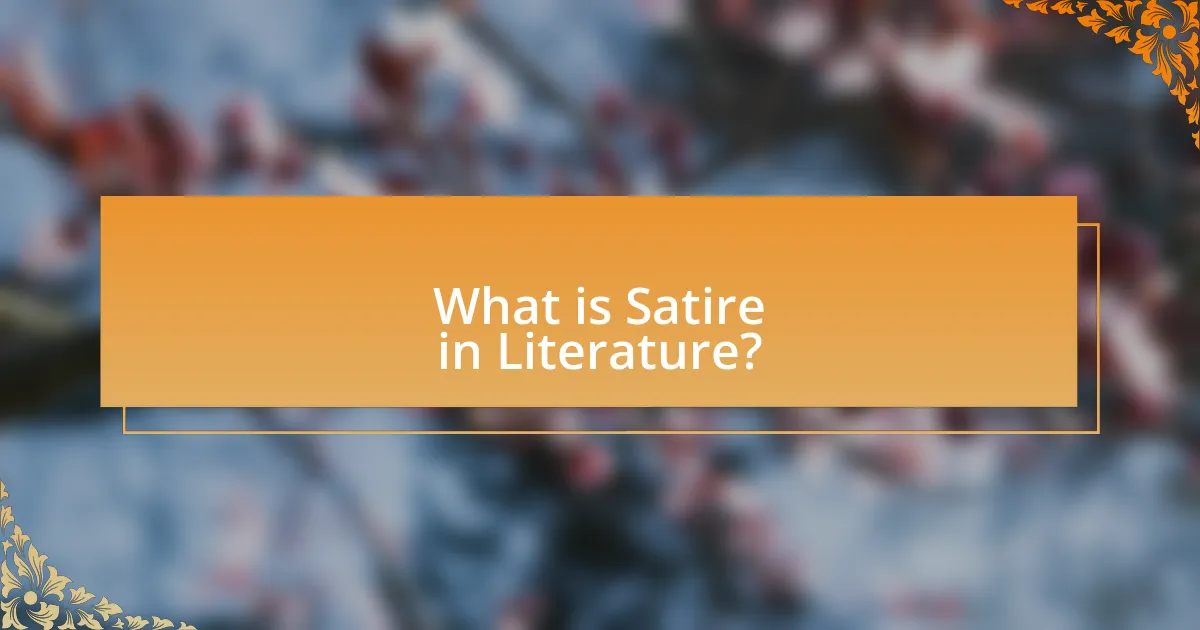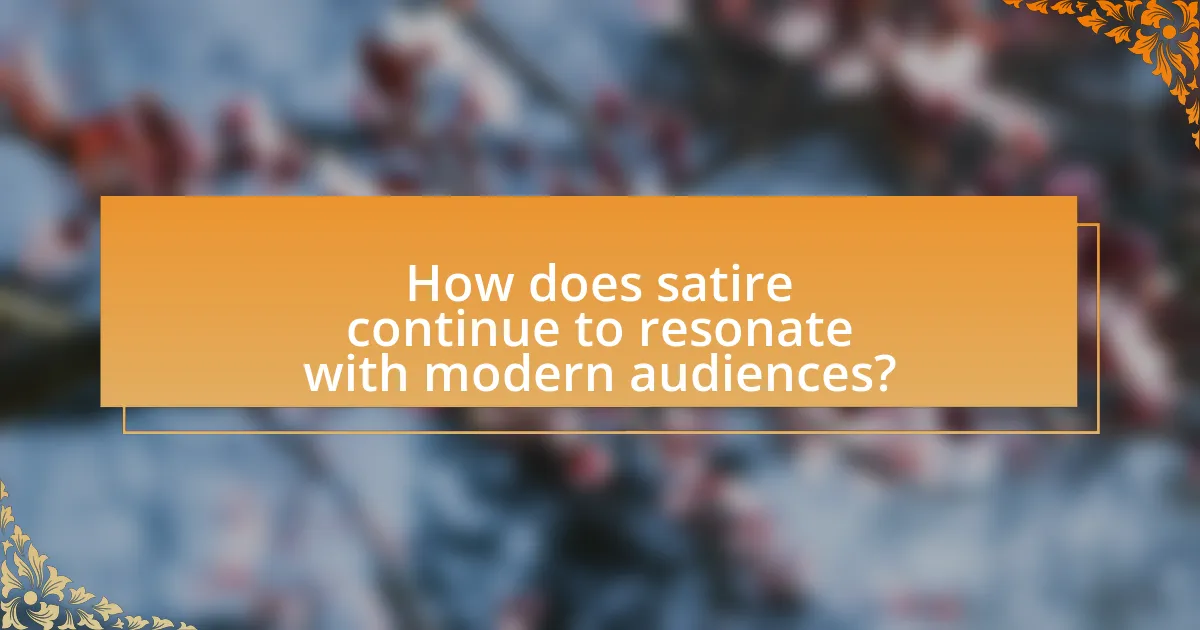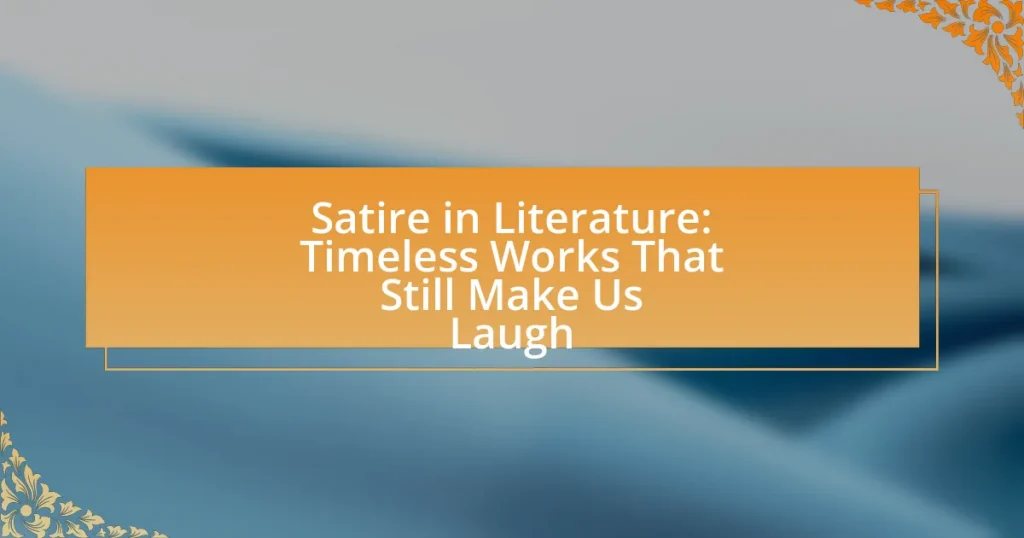Satire in literature is a genre that employs humor, irony, exaggeration, and ridicule to critique societal norms, individuals, and institutions, aiming to provoke thought and inspire change. The article explores the evolution of satire throughout literary history, highlighting significant works such as Jonathan Swift’s “A Modest Proposal” and George Orwell’s “Animal Farm,” which address social injustices and political corruption. It also examines the key characteristics of satire, its cultural interpretations, and its importance in social commentary, while discussing how modern technology has transformed the medium of satire and its relevance in contemporary discourse. Additionally, the article provides insights into renowned satirical authors, timeless themes, and techniques used in both classic and modern satirical literature.

What is Satire in Literature?
Satire in literature is a genre that uses humor, irony, exaggeration, or ridicule to criticize or mock societal norms, individuals, or institutions. This literary form aims to provoke thought and encourage change by highlighting flaws and absurdities in human behavior and societal structures. Notable examples include Jonathan Swift’s “A Modest Proposal,” which satirizes British policy towards the Irish, and George Orwell’s “Animal Farm,” which critiques totalitarianism. These works demonstrate how satire can effectively convey serious messages through comedic elements, making it a powerful tool for social commentary.
How has satire evolved throughout literary history?
Satire has evolved significantly throughout literary history, adapting to cultural and political contexts while maintaining its core purpose of critiquing societal norms and behaviors. In ancient literature, works like Aristophanes’ plays utilized humor to address political issues in Athens, while in the Middle Ages, satire often took the form of allegory, as seen in Dante’s “Divine Comedy,” which critiqued moral and religious corruption. The Renaissance brought forth writers like Erasmus and Rabelais, who employed satire to challenge established authorities and social conventions.
In the 18th century, Jonathan Swift’s “A Modest Proposal” exemplified the use of irony and hyperbole to address social injustices in Ireland, marking a shift towards more direct political commentary. The 19th century saw the rise of satirical novels, such as Charles Dickens’ “A Christmas Carol,” which critiqued Victorian society’s moral failings.
The 20th century introduced new forms of satire, including modernist and postmodernist approaches, with authors like George Orwell and Kurt Vonnegut using satire to comment on totalitarianism and absurdity in contemporary life. Today, satire continues to thrive in various media, including literature, television, and online platforms, reflecting ongoing societal issues while evolving in style and technique.
What are the key characteristics that define satire?
Satire is defined by its use of humor, irony, exaggeration, and ridicule to criticize or mock societal norms, individuals, or institutions. These characteristics enable satire to expose flaws and provoke thought, often aiming to inspire change or reflection. For instance, Jonathan Swift’s “A Modest Proposal” employs extreme exaggeration to highlight the dire situation of the Irish poor, effectively critiquing British policy. Additionally, satire often employs wit and clever language to engage the audience, making complex social issues more accessible and relatable.
How do different cultures interpret satire in literature?
Different cultures interpret satire in literature through their unique social, political, and historical contexts, which shape the themes and targets of satirical works. For instance, in Western cultures, satire often critiques political figures and societal norms, as seen in works like Jonathan Swift’s “A Modest Proposal,” which addresses issues of poverty and colonialism. In contrast, in Asian cultures, satire may focus more on moral lessons and social harmony, as exemplified by the Chinese classic “Journey to the West,” which uses humor to convey deeper philosophical insights. This variation in interpretation is supported by the fact that cultural values influence what is considered acceptable humor and the subjects deemed worthy of satire, leading to diverse expressions and receptions of satirical literature across different societies.
Why is satire important in literature?
Satire is important in literature because it serves as a powerful tool for social critique and reflection. By using humor, irony, and exaggeration, satire exposes societal flaws, injustices, and absurdities, prompting readers to question the status quo. Historical examples, such as Jonathan Swift’s “A Modest Proposal,” illustrate how satire can effectively highlight issues like poverty and colonialism, encouraging critical thought and dialogue. Additionally, satire often transcends cultural and temporal boundaries, making it a timeless medium for addressing universal human experiences and moral dilemmas.
What role does satire play in social commentary?
Satire serves as a critical tool in social commentary by exposing and ridiculing societal flaws, injustices, and absurdities. Through humor and exaggeration, satire encourages audiences to reflect on real issues, prompting discussions about morality, politics, and culture. Historical examples, such as Jonathan Swift’s “A Modest Proposal,” illustrate how satire can effectively critique social policies and provoke thought by presenting shocking solutions to serious problems. This method not only entertains but also fosters awareness and encourages change, making satire a powerful instrument in shaping public discourse.
How does satire influence public opinion and behavior?
Satire influences public opinion and behavior by using humor and exaggeration to critique societal norms, political issues, and cultural practices. This form of expression can provoke thought and discussion, leading audiences to reconsider their beliefs and attitudes. For instance, studies have shown that satirical content, such as television shows like “The Daily Show” and “Saturday Night Live,” can increase political awareness and engagement among viewers, particularly younger demographics. Research published in the journal “Political Communication” indicates that exposure to satirical news can enhance critical thinking about political issues, thereby shaping public discourse and potentially influencing voting behavior.

What are some timeless works of satire?
Timeless works of satire include “Gulliver’s Travels” by Jonathan Swift, “A Modest Proposal” also by Swift, “Animal Farm” by George Orwell, and “The Adventures of Huckleberry Finn” by Mark Twain. These texts critique societal norms, politics, and human behavior through humor and irony. For instance, “Gulliver’s Travels” uses fantastical elements to expose the absurdities of human nature and politics, while “Animal Farm” serves as an allegory for the Russian Revolution, illustrating the dangers of totalitarianism. Each of these works has maintained relevance over time due to their incisive commentary and enduring themes.
Which authors are renowned for their satirical works?
Authors renowned for their satirical works include Jonathan Swift, Mark Twain, and George Orwell. Jonathan Swift is best known for “Gulliver’s Travels,” which critiques human nature and society through absurdity. Mark Twain’s “The Adventures of Huckleberry Finn” employs humor to address serious social issues like racism and morality. George Orwell’s “Animal Farm” uses allegory to satirize totalitarian regimes, particularly Stalinist Russia. These authors have made significant contributions to the genre, using satire to provoke thought and entertain readers.
What themes are commonly explored in their satirical literature?
Common themes explored in satirical literature include social criticism, political corruption, and human folly. Satirical works often highlight the absurdities of societal norms and the flaws in human behavior, using humor to provoke thought and reflection. For instance, Jonathan Swift’s “A Modest Proposal” critiques British policy towards the Irish by suggesting extreme solutions, thereby exposing the moral indifference of the ruling class. Similarly, George Orwell’s “Animal Farm” uses allegory to comment on the corruption of socialist ideals in the Soviet Union, illustrating how power can corrupt even the noblest of intentions. These examples demonstrate how satire serves as a powerful tool for examining and challenging prevailing attitudes and injustices.
How do these authors use humor to convey their messages?
Authors use humor in satire to highlight societal flaws and provoke critical thought. By employing wit, irony, and exaggeration, they create a comedic lens through which readers can examine serious issues. For instance, Jonathan Swift’s “A Modest Proposal” uses absurdity to critique British policy towards the Irish, making the harsh realities of poverty more palpable through dark humor. Similarly, Mark Twain’s “The Adventures of Huckleberry Finn” employs satire to address racism and moral dilemmas, using humor to engage readers while prompting reflection on ethical issues. These techniques effectively convey messages by making them accessible and thought-provoking, encouraging audiences to reconsider their perspectives.
What are the most significant satirical works across different eras?
The most significant satirical works across different eras include “The Canterbury Tales” by Geoffrey Chaucer, “Gulliver’s Travels” by Jonathan Swift, “A Modest Proposal” also by Swift, “The Adventures of Huckleberry Finn” by Mark Twain, “Animal Farm” by George Orwell, and “Catch-22” by Joseph Heller. These works exemplify the use of humor and irony to critique societal norms and political issues. For instance, “Gulliver’s Travels” critiques human nature and politics through fantastical narratives, while “Animal Farm” serves as an allegory for the Russian Revolution, highlighting the dangers of totalitarianism. Each of these texts has had a profound impact on literature and continues to resonate with readers, demonstrating the enduring power of satire to provoke thought and inspire change.
How do these works reflect the societal issues of their time?
Satirical works reflect the societal issues of their time by critiquing prevailing norms, politics, and human behavior. For instance, Jonathan Swift’s “A Modest Proposal” addresses the dire poverty and exploitation in 18th-century Ireland through shocking irony, highlighting the inaction of the British government. Similarly, George Orwell’s “Animal Farm” serves as an allegory for the Russian Revolution, exposing the corruption and betrayal of revolutionary ideals. These examples demonstrate how satire not only entertains but also provokes critical thought about social injustices and encourages reform by holding power accountable.
What makes these works relevant today?
Satirical works remain relevant today due to their ability to critique societal norms and human behavior, often highlighting issues that persist across generations. For instance, Jonathan Swift’s “A Modest Proposal” continues to resonate as it addresses themes of poverty and exploitation, reflecting ongoing social injustices. Similarly, George Orwell’s “Animal Farm” serves as a powerful allegory for political corruption and totalitarianism, relevant in contemporary discussions about governance and power dynamics. These works utilize humor and irony to provoke thought and inspire change, making them enduringly significant in modern discourse.

How does satire continue to resonate with modern audiences?
Satire continues to resonate with modern audiences by effectively critiquing societal norms and political issues through humor and exaggeration. This form of expression allows individuals to confront uncomfortable truths in a digestible manner, making complex topics more accessible. For instance, contemporary satirical works like “The Onion” and “Saturday Night Live” utilize current events to highlight absurdities in politics and culture, engaging audiences by reflecting their frustrations and experiences. Research indicates that satire can enhance critical thinking and promote social awareness, as seen in studies by the Pew Research Center, which found that satirical content often encourages discussions about real-world issues among viewers.
What techniques do contemporary writers use in satire?
Contemporary writers use techniques such as exaggeration, irony, parody, and social commentary in satire. Exaggeration amplifies flaws or absurdities in subjects, making them more noticeable and humorous. Irony creates a contrast between expectations and reality, often highlighting hypocrisy or contradictions in society. Parody mimics the style of a particular genre or work to critique it, while social commentary addresses current events or societal issues, prompting reflection and discussion. These techniques are effective in engaging readers and provoking thought, as seen in works by authors like Jonathan Swift and George Orwell, who utilized these methods to critique political and social norms.
How has the medium of satire changed with technology?
The medium of satire has evolved significantly with technology, transitioning from print and oral traditions to digital platforms. Historically, satire was primarily disseminated through newspapers, pamphlets, and books, allowing for limited reach and slower distribution. With the advent of the internet and social media, satirical content can now be shared instantly and widely, reaching global audiences in real-time. For example, platforms like Twitter and YouTube enable creators to produce and distribute satirical videos and memes that can go viral, amplifying their impact. This shift has also led to the rise of new forms of satire, such as webcomics and satirical podcasts, which cater to diverse audiences and preferences. The immediacy and accessibility of digital technology have transformed how satire is created, consumed, and engaged with, making it a more dynamic and interactive medium.
What are some examples of modern satirical literature?
Some examples of modern satirical literature include “The Sellout” by Paul Beatty, “Thank You for Smoking” by Christopher Buckley, and “The Brief Wondrous Life of Oscar Wao” by Junot Díaz. “The Sellout” won the Man Booker Prize in 2016 and critiques race relations in America through dark humor. “Thank You for Smoking” satirizes the tobacco industry and lobbyists, highlighting moral ambiguity in corporate America. “The Brief Wondrous Life of Oscar Wao” employs satire to address the Dominican-American experience and the impact of dictatorship, blending humor with serious themes. These works exemplify how modern satire continues to engage with social and political issues.
How can readers appreciate and analyze satire effectively?
Readers can appreciate and analyze satire effectively by understanding its context, recognizing its use of irony, and identifying the target of the satire. Context is crucial, as satire often reflects societal norms, political climates, or cultural issues at the time of its creation, allowing readers to grasp the underlying message. Irony plays a significant role in satire, where the intended meaning contrasts with the literal meaning, prompting readers to think critically about the implications. Additionally, identifying the target—be it individuals, institutions, or societal behaviors—enables readers to evaluate the effectiveness of the satire in conveying its critique. For instance, Jonathan Swift’s “A Modest Proposal” uses irony to address the dire economic conditions in Ireland, making readers reflect on the moral implications of his argument. This combination of context, irony, and target identification equips readers with the tools to engage deeply with satirical works.
What skills are necessary for understanding satirical texts?
Understanding satirical texts requires critical thinking, cultural awareness, and an appreciation for humor. Critical thinking enables readers to analyze the underlying messages and intentions behind the satire, while cultural awareness helps them recognize the social and political contexts that inform the satire. An appreciation for humor allows readers to engage with the text on a deeper level, recognizing irony, exaggeration, and parody as tools used by the author. These skills are essential for interpreting the nuances and complexities inherent in satirical works, which often rely on a shared understanding of societal norms and values to convey their messages effectively.
How can readers identify the underlying messages in satire?
Readers can identify the underlying messages in satire by analyzing the exaggeration, irony, and humor used to critique societal norms or behaviors. Satirical works often employ these techniques to highlight contradictions or absurdities in real-life situations, prompting readers to reflect on the deeper implications. For instance, Jonathan Swift’s “A Modest Proposal” uses shocking irony to criticize British policy towards the Irish, revealing the inhumanity of exploitation. By recognizing these literary devices and understanding the context in which the satire was created, readers can uncover the critical commentary embedded within the humor.
What are some tips for engaging with satirical literature?
To engage effectively with satirical literature, readers should first understand the context and the societal issues being critiqued. This understanding enhances appreciation of the humor and the underlying messages. Additionally, readers should pay attention to the use of irony, exaggeration, and parody, as these are key elements that drive satire. Recognizing the author’s tone and intent is crucial, as it helps in deciphering the layers of meaning within the text. Engaging with discussions or analyses of the work can also provide deeper insights, as many satirical pieces reference contemporary events or cultural norms, making them more impactful when contextualized.



